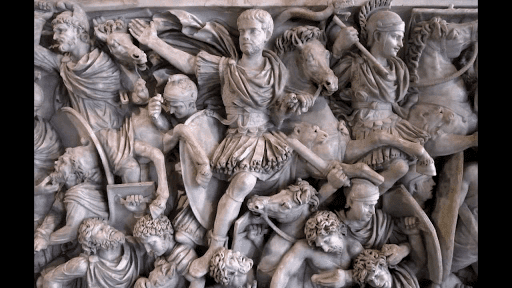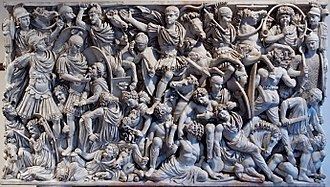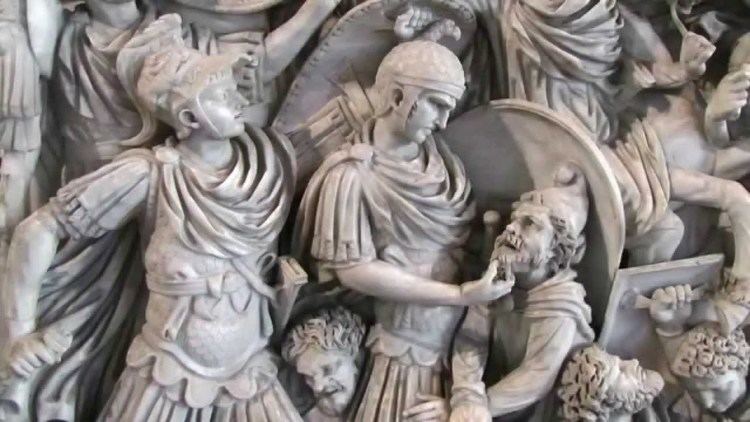 | ||
Similar Portonaccio sarcophagus, Augustus of Prima Porta, Portrait of the Four Tetrarchs, Ludovisi Gaul, Ludovisi Throne | ||
Ludovisi battle sarcophagus
The Ludovisi Battle sarcophagus or "Great" Ludovisi sarcophagus is an ancient Roman sarcophagus dating to around 250–260 AD from a tomb near the Porta Tiburtina. It is also known as the Via Tiburtina Sarcophagus, though other sarcophagi have been found there. It is known for its densely populated, anti-classical composition of "writhing and highly emotive" Romans and Goths, and is an example of the battle scenes favored in Roman art during the Crisis of the Third Century. Discovered in 1621 and named for its first modern owner, Ludovico Ludovisi, the sarcophagus is now displayed at the Palazzo Altemps in Rome, part of the National Museum of Rome.
Contents

The sarcophagus is a late outlier in a group of about twenty-five late Roman battle sarcophagi, the others all apparently dating to 170-210, made in Rome or in some cases Athens. These derive from Hellenistic monuments from Pergamon in Asia Minor showing Pergamene victories over the Gauls, and were all presumably commissioned for military commanders. The Portonaccio sarcophagus is the best known and most elaborate of the main Antonine group, and shows both considerable similarities to the Great Ludovisi sarcophagus, and a considerable contrast in style and mood.

Ludovisi battle sarcophagus
Description

The sarcophagus measures 1.53m in height and is made from Proconnesian marble, a medium characterized by dark gray stripes and a medium to coarse grain. It is decorated in a very high relief with many elements of the composition cut completely free of the background. Overlapping figures entirely fill the image space, allowing no room to depict a background. In many battle sarcophagi the side panels show more tranquil scenes, but here the battle continues round both sides.

The lid of the sarcophagus depicts barbarian children handed over to a Roman general by men presumably their fathers. Children were sometimes taken into Roman custody as pledges of peace, and might be reeducated as Romans. The lid, which was broken in 1945 while on display in Mainz, also shows a bust of a female figure.

The central figure of the tortuous composition on the front is a young Roman military commander on horseback, presumed to represent the deceased. His face is serene, and his arm is extended confidently in a "gesture which is difficult to interpret but seems to be one of farewell". An X-mark on his forehead has been interpreted as the cross received by initiates into the Mithraic mysteries as a sign of the god Mithras' favor. The Mithraic religion was popular among Roman soldiers. The valor (virtus) shown by the horseman may represent real-life bravery on the battlefield, but the religious connotation of the X may suggest victory over death, a theme of mounted warriors in funerary art. The horseman probably represents the deceased.
The figure is sometimes identified as the younger son of the emperor Decius, Hostilian, who reigned briefly in the year 251. Decius and his older son, Herennius, whom he had made his co-ruler, were killed in battle against a federation of Scythians under the command of the Gothic king Cniva. They were the first Roman emperors to die in battle at the hands of a foreign enemy. Despite the battle imagery, Hostilian himself died of plague.
The sarcophagus contains many precise depictions of military details such as the draco military standard and a detailed mail shirt of the longer length characteristic of the period.
Technique and style
The undercutting of the deep relief exhibits virtuosic and very time-consuming drill work that conveys chaos and a sense of weary, open-ended victory. It differs from earlier battle scenes on sarcophagi in which more shallowly carved figures are less convoluted and intertwined. Describing it as "the finest of the third-century sarcophagi", art historian Donald Strong says:
The faces are strikingly unclassical, and the technique of deep drilling is particularly obvious in the manes of the horses and the shaggy hair of the barbarians. But the main difference [to the Portonaccio sarcophagus, a similar 2nd century work] is in the symbolism. The barbarians all seem frozen in the moment before disaster and death overwhelm them; their attitudes are highly theatrical but none the less immensely expressive... The main theme is no longer the glorification of military prowess but that of transcending the struggle, presumably conveying the notion of triumph over death ... The ugliness of pain and suffering is stressed by the dishevelled hair, the tormented eyes, the twisted mouth.
The carving is so deep that the forms are almost completely offset from the background resulting in three, or even four, layers of various figures and forms. What is more, overlapping figures fill the image space entirely, allowing no room to depict a background. Thus, the sense of space has been eliminated, giving rise to chaos and a sense of weary, open-ended victory. The effect of movement in the scene is evident and, unlike many battle sarcophagi which have more tranquil scenes on the side panels, the battle events continue all the way around the sarcophagus. The perspective constructed is also notable, although certainly not linear.
From the time of the reign of the Antonine emperors, Roman art increasingly depicted battles as chaotic, packed, single-plane scenes presenting dehumanized barbarians mercilessly subjugated by Roman military might, at a time when in fact the Roman Empire was undergoing constant invasions from external threats that led to the fall of the empire in the West. Although armed, the barbarian warriors, usually identified as Goths, are depicted as helpless to defend themselves. Various aspects of the execution of the work accentuate the contrast between the Romans and the Goths. The Roman figures are all clean-shaven and wear armour and helmets, which distinguish them clearly from the Goths, who are unarmoured and wear distinctive clothing, beards, and hairstyles. The Romans are given a nobler appearance with idealised physical features which contrast with the Goths who are almost caricatures, with enlarged noses, pronounced cheekbones, and wild expressions on their faces. The alternation of light/dark accentuates the contrast between the two groups. Shadows and deep carving are mostly found in the faces and hair of the Goths whereas the smooth surface of the marble is reserved for the Romans, who are less deeply carved.
Differences in scale between the figures, though present, are far less marked than in the earlier Portonaccio sarcophagus, such that the general is only slightly larger than his troops or enemies. Nor is the general seen wearing a helmet or in actual combat, as in the earlier sarcophagi.
